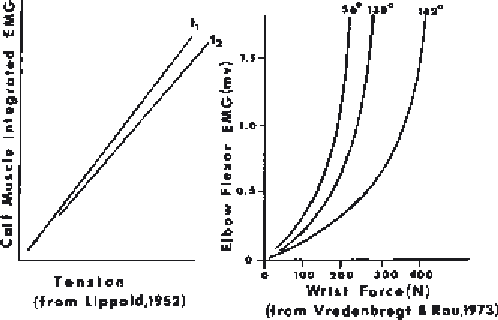Biomedical Engineering Reference
In-Depth Information
Figure 10.17
Relationship between the average amplitude of EMG and the tension
in the muscle in isometric contraction. Linear relationships have been shown by some
researchers, while others report the EMG amplitude to increase more rapidly than the
tension.
the muscle under certain length conditions; a reproduction of their results is
presented in Figure 10.17.
Another way of representing the level of EMG activity is to count the
action potentials over a given period of time. Close et al. (1960) showed a
linear relationship between the count rate and the integrated EMG, so it was
not surprising that the count rate increased with muscle tension in an almost
linear fashion.
The relationship between force and linear envelope EMG also holds during
dynamic changes of tension. Inman et al. (1952) first demonstrated this by a
series of force transducer signals that were closely matched by the envelope
EMG from the muscle generating the isometric force. Gottlieb and Agarwal
(1971) mathematically modeled this relationship with a second-order low-pass
system (e.g., a low-pass filter). Under dynamic contraction conditions, the
tension is seen to lag behind the EMG signal, as shown in Figure 10.18. The
delay is caused by the fact that the twitch corresponding to each m.u.a.p.
reaches its peak 40 - 100 ms afterward. Thus, as each motor unit is recruited,
the resulting summation of twitch forces will also have a similar delay behind
the EMG.
In spite of the reasonably reproducible relationships, the question still arises
as to how valid these relationships are for dynamic conditions when many
muscles act across the same joint:
1. How does the relationship change with length? Does the length change
merely alter the mechanical advantage of the muscle, or does the chang-
ing overlap of the muscle fibers affect the EMG itself (Vredenbregt and
Rau, 1973)?










Search WWH ::

Custom Search